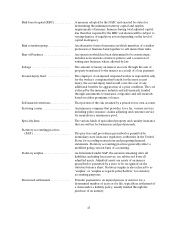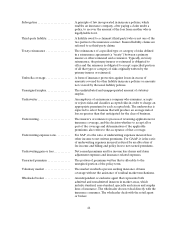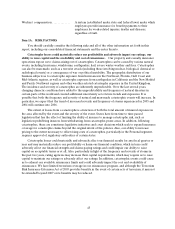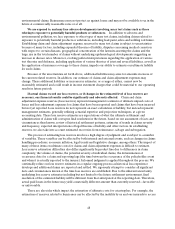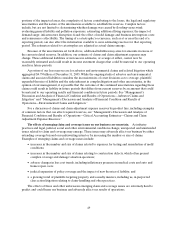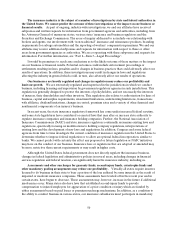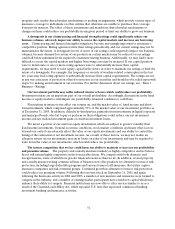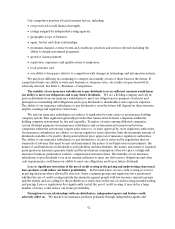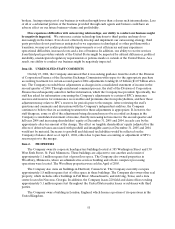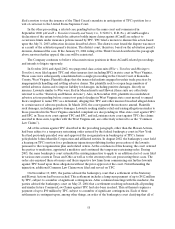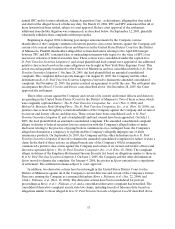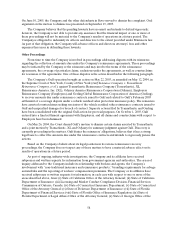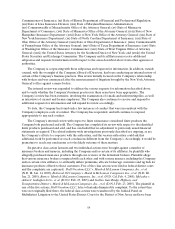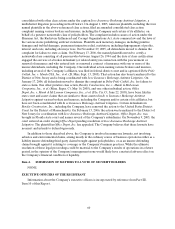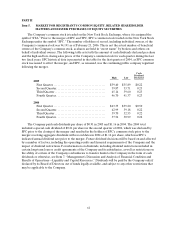Travelers 2005 Annual Report Download - page 64
Download and view the complete annual report
Please find page 64 of the 2005 Travelers annual report below. You can navigate through the pages in the report by either clicking on the pages listed below, or by using the keyword search tool below to find specific information within the annual report.52
Our competitive position is based on many factors, including:
•our perceived overall financial strength,
•ratings assigned by independent rating agencies,
•geographic scope of business,
•agent, broker and client relationships,
•premiums charged, contract terms and conditions, products and services offered (including the
ability to design customized programs),
•speed of claims payment,
•reputation, experience and qualifications of employees,
•local presence and
•our ability to keep pace relative to competitors with changes in technology and information systems.
We may have difficulty in continuing to compete successfully on any of these bases in the future. If
competition limits our ability to write new business at adequate rates, our results of operations willbe
adversely affected. See Item 1—Business—Competition.
The inability of our insurance subsidiaries to pay dividends to us in sufficient amounts would harm
our ability tomeet our obligations and to pay future dividends. We are a holding company and rely in
part on dividends from our insurance subsidiaries to meet our obligations for payment of interest and
principal on outstanding debt obligations and to pay dividends to shareholders and corporate expenses.
The ability of our insurance subsidiaries to pay dividends to us in the future will depend on their statutory
surplus, earnings and regulatory restrictions.
We and our insurance subsidiaries are subject to regulation by some states as an insurance holding
company system. This regulation generally provides that transactions between companies within the
holding company system must be fair and equitable. Transfers of assets among affiliated companies,
certain dividend payments from insurance subsidiaries and certain material transactions between
companies withinthe system may require prior notice to, or prior approval by, state regulatory authorities.
Our insurance subsidiaries are subject to various regulatory restrictions that limit the maximum amount of
dividends available to be paid to their parent without prior approval of insurance regulatory authorities.
The ability of our insurance subsidiaries to pay dividends to us also is restricted by regulations that set
standards of solvency that must be met and maintained, the nature of and limitation oninvestments, the
nature of and limitations on dividends to policyholders and shareholders, the nature and extent of required
participation in insurance guaranty fundsand the involuntary assumption of hard-to-place or high-risk
insurance business, primarily in workers’ compensation insurance lines. The inability of our insurance
subsidiaries to pay dividends to us in an amount sufficient to meet our debt service obligations and other
cash requirements could harm our ability to meet our obligations and to pay future dividends.
Loss or significant restriction of the use of credit scoring in the pricing and underwriting of personal
lines products could reduceour future profitability. In Personal Lines, weuse credit scoring as a factor
in pricing decisions where allowed by state law. Some consumer groups and regulators have questioned
whether the use of credit scoring unfairly discriminates against people with low incomes, minority groups
and the elderly and are calling for the prohibition or restriction on the use of credit scoring in underwriting
and pricing. Laws or regulations that significantly curtail the use of credit scoring, if enacted in a large
number of states, could reduce our future profitability.
Disruptions to our relationships with our distributors, independent agents and brokers could
adversely affect us.We market our insurance products primarily through independent agents and



